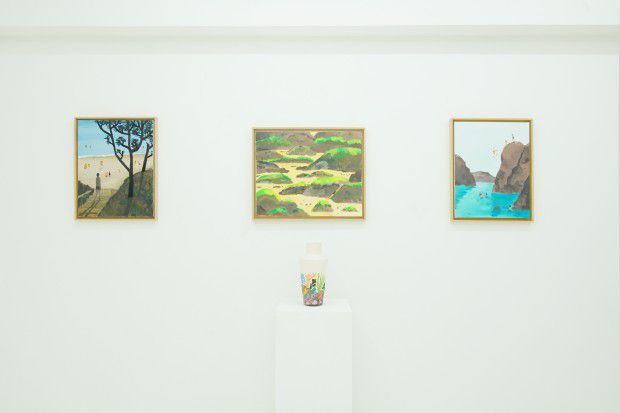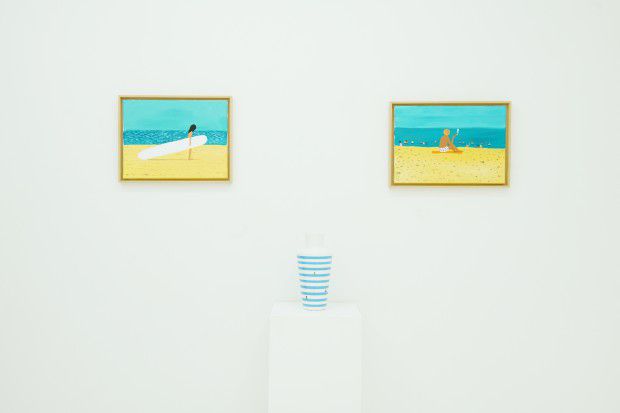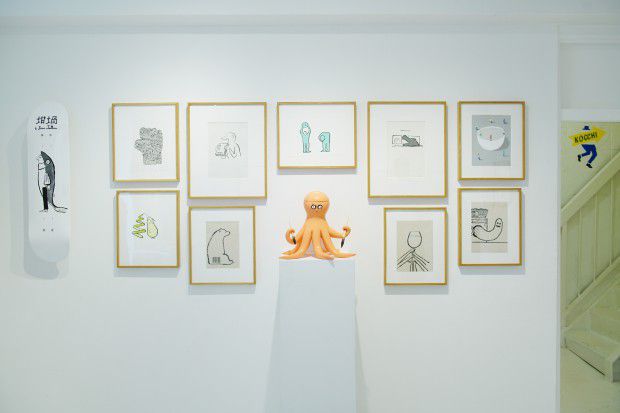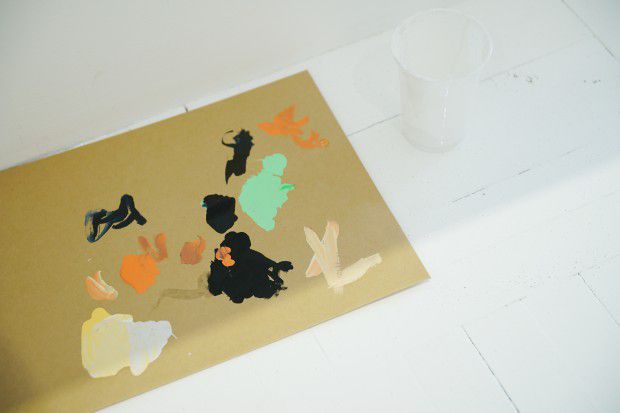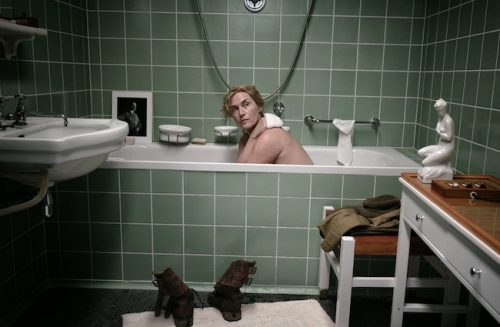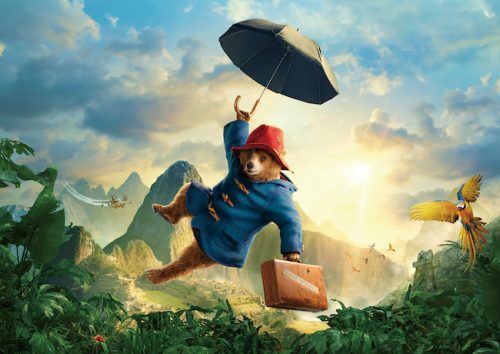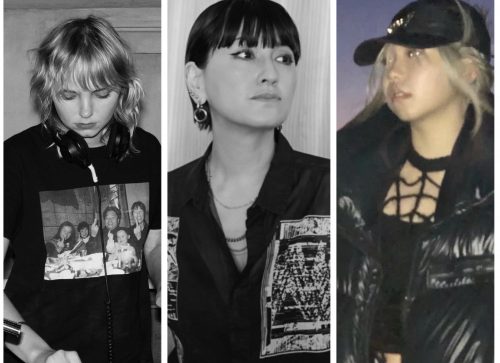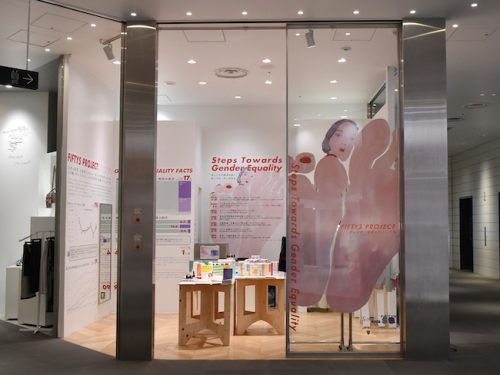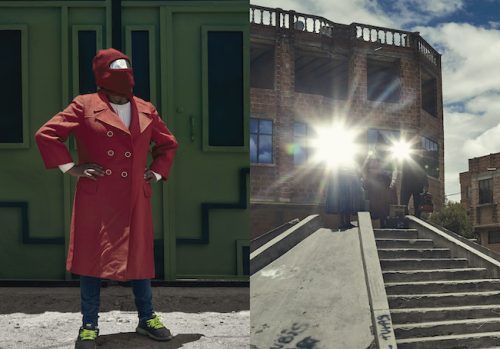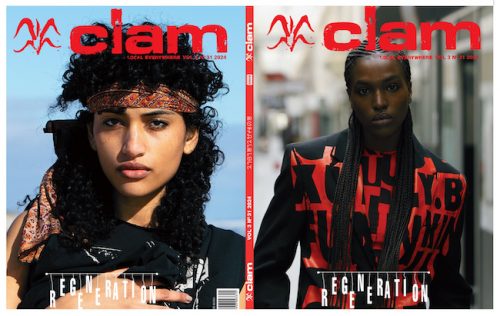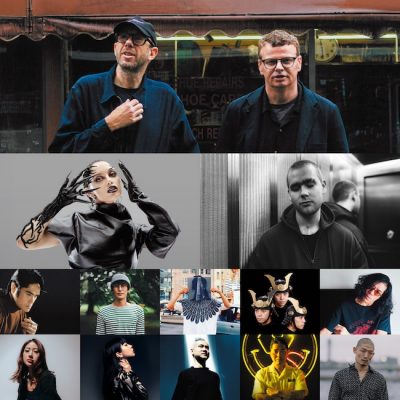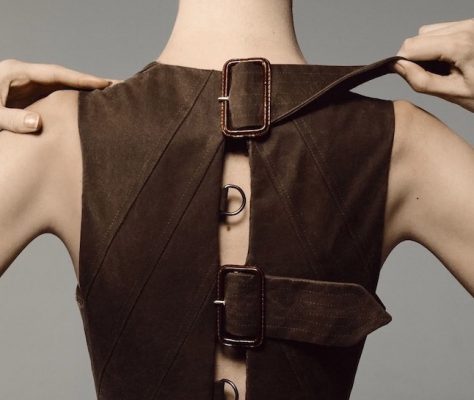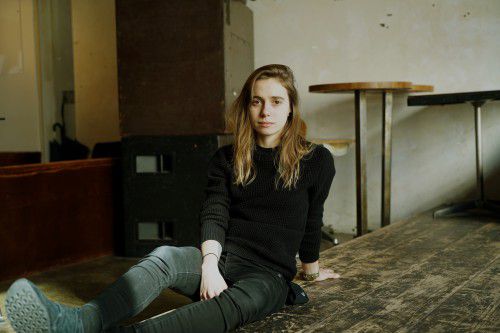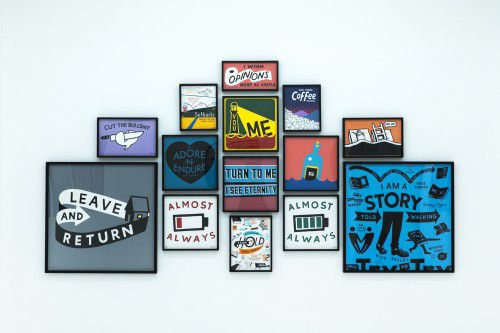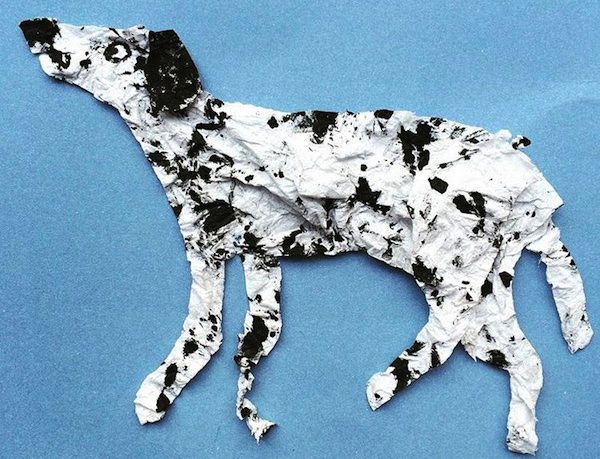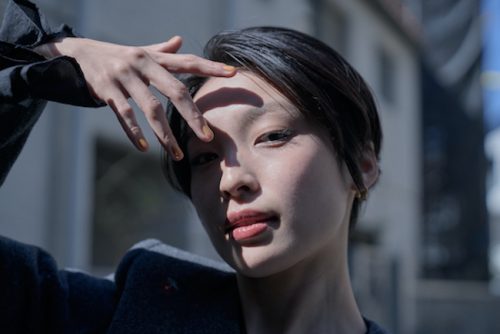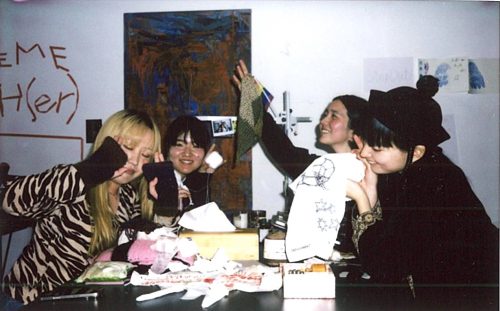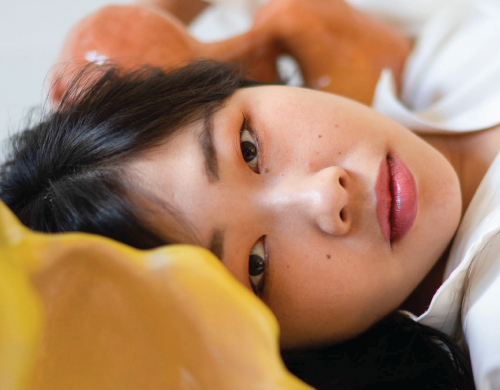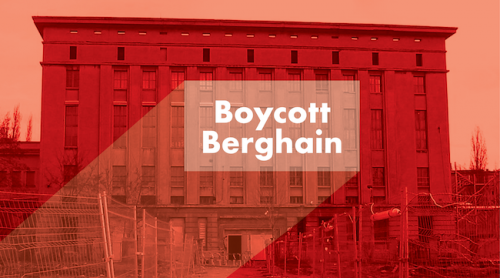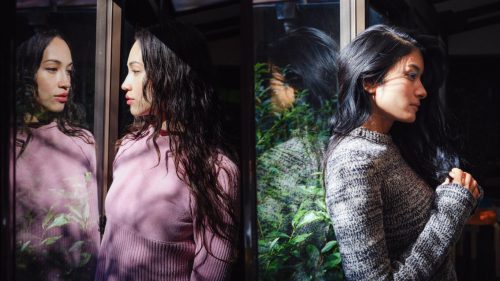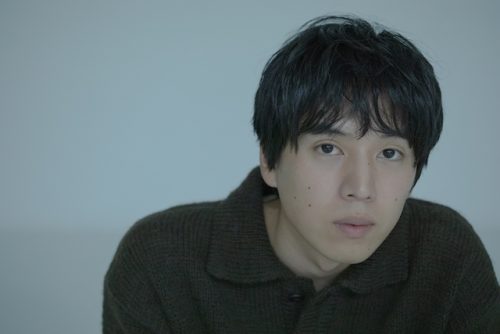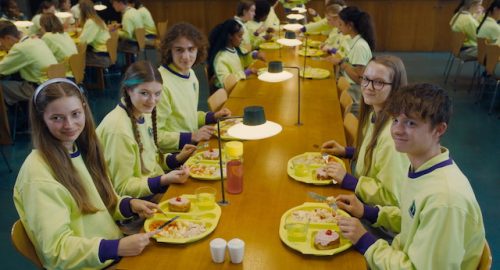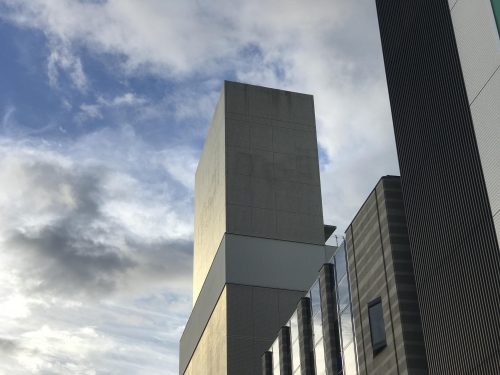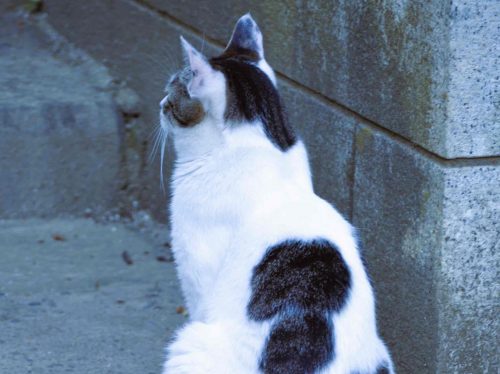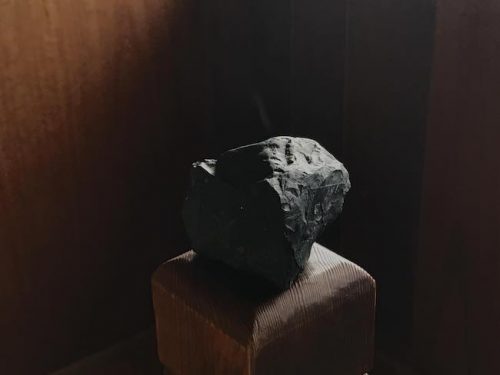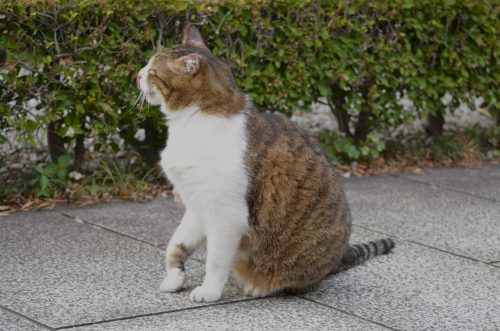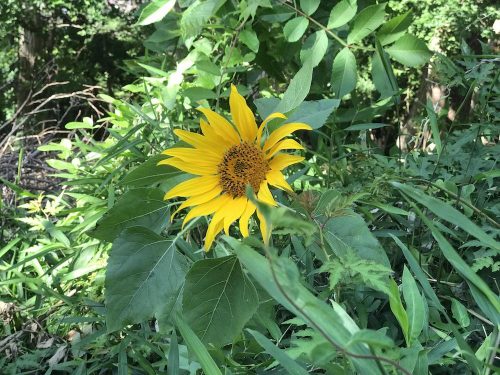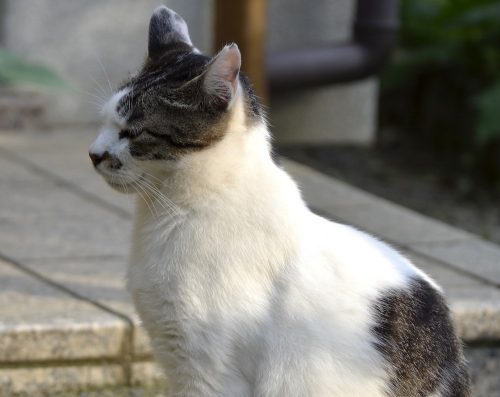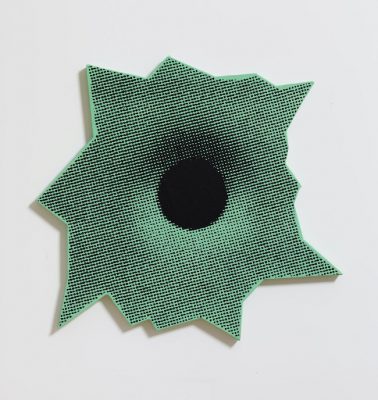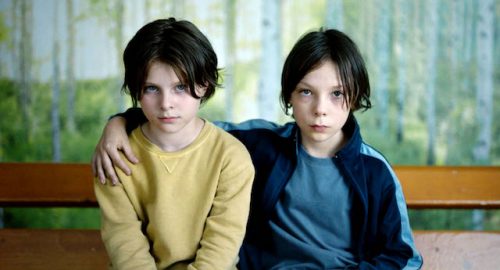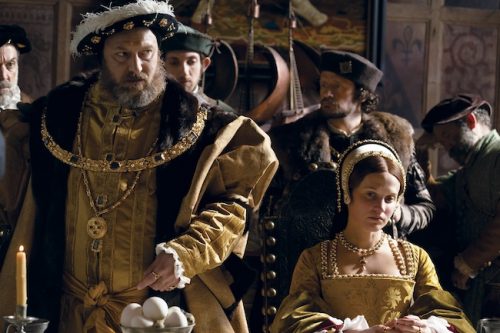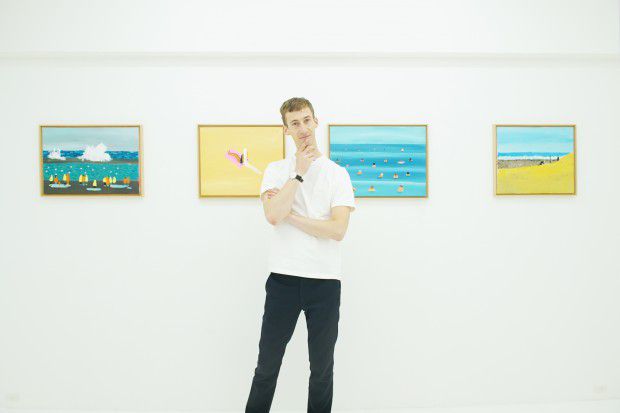
フランスで生まれ、ロンドンを拠点に活躍するグラフィックアーティスト、ジャン・ジュリアンが、初となる東京での個展「同じ海」を原宿のGALLERY TARGETにて開催している。クスッと笑える日常の瞬間を独特のタッチで描いたイラストレーションが人気で、ニューヨーカー誌、ウォール・ストリート・ジャーナル、UNICEF、ロンドン交通局など、世界中に多彩なクライアントを持つ彼の作品を、一度は目にしたことがあるだろう。ここでは、まるで自身の描いた絵から飛び出てきたようなジュリアン氏に、今回の個展に込めた思いやインスピレーションなどについて聞いた。
——日本へようこそ。久しぶりの来日はいかがですか?
——Welcome back to Japan. How do you feel to be back?
ジャン・ジュリアン「素晴らしいよ。僕にとってはものすごく刺激的なんだ。(日本は)視覚的にも文化的にもエキサイティングで…なぜだかわからないけど、とても心が休まる場所。子どもの頃、アニメを観て育ったんだけど、ある意味、それが日本のポップカルチャーへの入門だったんだ。でも大人になるにつれて、日本のデザインや建築、伝統的な家などに興味がシフトしていった。僕はポップと伝統のミクスチャーが大好きなんだ。今回は東京で開催する初めての個展だから、みんなが気に入ってくれるとうれしいね」
“Amazing. I find it really inspiring. (Japan is) exciting visually and culturally… I don’t know, I just feel quite at home. I grew up watching a lot of anime, which sort of was like a pop culture introduction to Japan. But then, growing up, it was really more about Japanese design, architecture, traditional housing and things like that. I really like the mixture of pop and traditional. This is my very first show in Tokyo, so I hope people will like it.”
——まずはバックグラウンドを教えてください。
——Please tell us a bit about your background.
ジャン・ジュリアン「僕はフランス出身で、ブルターニュ半島の西海岸にあるナントという街で育った。そして18歳の誕生日くらいに、グラフィックデザインを勉強するためにフランス西部のカンペールに引っ越して、小さい学校に3年間通ったんだ。とても実用的なコースだった。グラフィックデザインを勉強することになったのは偶然で、アニメーションの学校に入れなかったから。だから少し悲しかったし、当時は(グラフィックデザインは)つまらなそうだと思っていたんだ。でも、とても良い先生に出会って、ソール・バスのような人たちの作品を見せてくれた。彼らはファッション広告など、実用的なデザインを手がけながらも、生来のアーティストなんだ。まるで本やギャラリーの仕事と同じくらいのクリエイティビティと情熱を(広告にも)注いでいた。それで、これは素晴らしいな!と思ったんだ。自己表現をしたり、クリエイティブであったりしながらも、生計を立てられる方法は1つではないのだと気づいた。僕はコマーシャルな仕事のポップカルチャー的な側面が好きなんだ。誰もが絵を買えるわけではないけれど、もしTシャツのグラフィックを手がけたとして、そこにちゃんと誠意を込めれば、より多くの人に自分のクリエイティビティを届けられる手段となり得るんだ」
“I’m originally French. I come from a city called Nantes, which is on the edge of the west coast Brittany. I moved around my 18th birthday to Quimper, which is on the far west of France, to study graphic design in a small school for three years. It was a very practical course. I studied graphic design kind of by accident, because I didn’t get accepted to the school for animation. So I was bit sad and it seemed boring at the time. But I had really good teachers who showed me works of people like Saul Bass who were doing practical designs for fashion advertising or whatever, but real artists in their own rights. They were injecting the same amount of creativity and passion in what they were doing commercially, as if they were doing it for a book or a gallery. And I thought, ‘this is amazing!’ You know, there is just not one way to express or be creative but you can also earn a living. And I like the pop culture aspect of doing commercial work. Not everybody can buy a painting, but if you do graphics on a t-shirt, and if you are quite sincere with what you do, it’s a nice way to bring your creativity to more people.”
——ロンドンにはいつ引っ越したのですか?
——When did you move to London?
ジャン・ジュリアン「(カンペールの学校で)学んだことが気に入ったから、ロンドンのセントラル・セント・マーティンズに3年間通って、グラフィックデザインの修士号を取得した。さらにその後、ロイヤル・カレッジ・オブ・アートでヴィジュアルコミュニケーションを学んだ。つまりは、僕はイラストレーションではなく、グラフィックデザインを8年間勉強したんだ(笑)」
“I really liked what I discovered, so I moved to London to study at Central Saint Martins for BA in graphic design again for three years. Then after that, I went to Royal College of Art to study visual communication. So that’s eight years of graphic design but illustration [laughs.]”
——8年とは長いですね。
——That sounds like a lot of work.
ジャン・ジュリアン「そうだね。でも、とても自然な流れだった。セント・マーティンズで勉強していた頃、僕はラッキーなことに、友だちのコンサートのポスターなどを手がけることができたんだ。そして、インターネットやブログカルチャーのおかげで、僕の作品は少しずつ世に出ていった。だから、ただ勉強しているだけという気分ではなかったよ。それよりも、失敗が許される安全な避難所という感じ。何しろ学校だからね」
“Yeah, but it felt quite organic because when I was studying at Saint Martins, I was lucky to make posters for friends’ concerts and things like that. And thanks to the Internet and blog culture, my work has gotten to be seen bit more and bit more. It didn’t feel like just studying, it felt more like a safe haven to practice where you could fail, because it’s school. ”
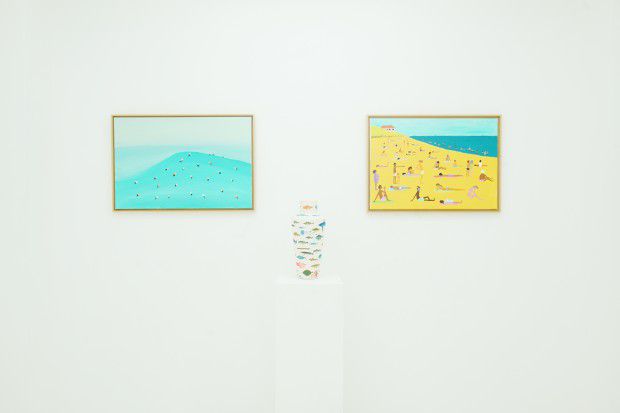
——子どもの頃からクリエイティブでしたか?アート系の家庭で育ったのですか?
——Were you always creative? Did you grow up in an artistic family?
ジャン・ジュリアン「そうだね。母は建築家とキュレーター。父は都市計画の仕事をしている。一見アーティスティックに思われないかもしれないけれど、そこには芸術があるんだ。それに父は熱心なミュージシャンであり、たくさんのコミックを読んでいた。姉はプロダクトデザイナーで、今はブルゴーニュでコンセプトストアを経営している。そして兄はミュージシャンとアニメーターで、僕らはロンドンでスタジオをシェアしているんだ」
“Yes. My mom is an architect and curator. My dad was a town planner, which might not seem most artistic, but there is artistry in it. And he was a very keen musician and read a lot of comic books. My sister is a product designer originally, and now she has a concept store in Brittany. And My brother is a musician and animator, we share a studio in London.”
——お兄さんとはジュリアン・ブラザーズという動画のプロジェクトをやっているんですよね? お二人の作るアニメーションが大好きです。とてもスイートで。
——You and your brother has a moving image project called Jullien Brothers, right? I love your animations. They are very sweet.
ジャン・ジュリアン「ありがとう。作るのもすごく楽しいんだ」
“Thank you. They are really fun to make.”
——グラフィックデザインを勉強したということですが、あなたのデザインには、とても力強い素晴らしいイラストの要素が含まれています。グラフィックデザインからイラストレーションへは、どのように進化していったのですか?
——So you studied graphic design, but you have very strong illustration elements in your designs and they are amazing. How do you think it evolved from graphic design to illustration?
ジャン・ジュリアン「うーん…偶然みたいなものなんだよね、実際に。最初にコンサートのポスターを手がけていた頃、僕はフォトモンタージュを作っていたんだ。小さなステージを作って、紙で作ったキャラクターを乗せて、バックグラウンドを作って、写真を撮影していた。時にキャラクターを目立たせるために、黒いブラシでラインを引いて縁取りした。でも忙しくなるにつれて、常に写真を撮る時間や場所がなかったんだ。だからセットを平らにして、それがイラストレーションになった感じだよ」
“Um… kind of by accident, actually. At the beginning, when I was making posters for concerts, I used photo montages making a small stage with paper cut of characters and put on a background then taking a photo. And sometimes, to highlight the characters, I used black brush lines around. As I got busier and busier, I didn’t have time or the facilities to make photos all the time. So I sort of flattened the sets and it became illustration.”
——ソール・バスのように、コマーシャルな作品においても、ご自身のアーティスティックなスタイルを妥協しないところがすてきですね。
——It’s nice to see how you maintain your own artistic style in your commercial work, just like Saul Bass did.
ジャン・ジュリアン「その理由は、僕がどんな媒体であれ、違いのないように手がけているからだと思う。Tシャツだろうが広告ポスターだろうが絵だろうが、同じ人がやっていることだからね。ある意味、自分が望んでいたような結果にはならないかもしれない。クライアントと仕事をするときは話し合いながら進めるから、時には変更を求められることもある。それがゲームの一部なんだ。自分が普段やることと結果が違っても、それは普通のこと。でもラッキーなことに、みんなそれを理解してくれて、僕に自己表現させてくれる」
“That’s because I try not to make differences in the mediums I work with. If I do a shirt or advertising poster or painting, it’s the same person doing it. In a way, when the end result might not be as good as what I wanted it to be, it’s sometimes just because when you work with a client, it’s a discussion, and sometimes they give you feedbacks to change things, and you know, it’s part of the game. It’s kind of normal that the end result is not the same as what you would do. But the intention at the beginning is always the same. And I think I’m quite lucky that people seem to have understood and appreciate that, and let me express myself.”
——ご自身のクリエイティビティを保ちつつクライアントのニーズに応える上で、苦労することはありますか?
——Do you sometimes find it hard to meet your clients’ needs while keeping your own creativity?
ジャン・ジュリアン「あるよ。彼らは僕よりもたくさんの人に届けることができるからね。だから、自分がハッピーでなければ残念だなと思うけど、正直いってそんなことは滅多にないんだ。それに、誰かにバリアを張られると、より革新的かつクリエイティブにしようとがんばるようになる。自分自身の作品でクリエイティブになることもできるけど、僕はそういったチャレンジを非常にエキサイティングだと感じるんだ。だから確かに苦労することもあるけれど、振り返ってみると、それがより良いことだったのだとわかる」
“I do because they have more reach than me. So sometimes I find it that it could be a pity if I’m not happy, but it doesn’t really happen very often to be honest. Also, I think it really pushes you to be inventive and more creative when someone puts a barrier. You can be very creative on your own, but I do find the challenge quite exciting. So yes, sometimes I find it difficult, but when I look back at it, I know that it was for the greater good.”
——イラストレーションにブラシで引いた黒いラインを使い始めたのはどうして?
——How did you start using black brush lines in your illustrations?
ジャン・ジュリアン「自分にはうまく絵が描けないと気づいたからなんだ。技術的な絵や写実的な絵は、僕には無理だった。描けなかったし、(写実的な絵を描くのだったら)写真を撮ればいいと思った。ブラシでラインを引くときは失敗も許されるんだ。ラフにブラシを使うと、たくさんのミスが出るからね。例えて言えば、僕にとっては野生の馬に乗るようなもの。特定の方向に導くべく、最大の努力をするような感じだよ。僕の絵における黒いラインはそんな感じなんだ。今では自分の言語になっているから、前よりも自信がある。完璧じゃなかったとしても、僕なりのABCを作ったから。自分の言語でどうやってキャラクターを描くかわかっているし、自分の言語でどうやって犬を描くかもわかっている。自分の文字を使って文章を作り、文章を使って物語を伝えるんだ」
“By just realizing I couldn’t draw very well. So for me having technical drawings or realistic drawing didn’t really make sense. I couldn’t do it and I also thought I might as well take a photo. And so brush lines allow a lot of mistakes, because if you use it in a rough way, there are a lot of mistakes. Forgive me my analogy, but for me it’s like trying to ride a wild horse. You try your best to guide it to one direction. That’s how I see my black brush lines in my drawings. I feel more confident with it now because it’s my language. So even if it’s not perfect I’ve created my A, B, C letters with it. So I know how to draw a character in my language, and I know how to draw a dog in my language, so those are my letters and I can form sentences and tell stories with those sentences.”
——あなたがスケートボーダーのロドニー・マレンと対談した動画を観たのですが、その中で日本の筆ペンを使っていたように見えたのですが。
——I was watching the video where you were talking to Rodney Mullen, and I think I saw you using a Japanese brush pen.
ジャン・ジュリアン「うん、常にあのペンを使っているよ。昨日ちょうど誰かと自分の仕事道具について話していていたんだ。僕の絵の具は日本製のホルベイン・アクリラで、ブラシは伊東屋から輸入している日本製だよ。そして(今回の個展の)1階にある展示作品は、無印良品のリサイクルペーパーに描いた。僕は常に同じツールを使っているんだ」
“Yeah, that’s what I use all the time. It’s funny I was talking to someone yesterday about my tools. And the paint I use is Japanese. It’s Holbein Acryla. And I import acrylic brushes from Ito-ya. Brushes are always Japanese. And the paper I used for the works downstairs is Muji recycled paper. I always use the same tool.”
——あの動画ではロドニー・マレンとスケートボードについて語っていましたが、子どもの頃からスケートしていたのですか?
——So in that clip, you were talking to Rodney Mullen about skating. Did you grow up skating?
ジャン・ジュリアン「スケートは確実に僕の10代の一部だった。そしてその後、グラフィックデザインを学ぶようになってから気づいたことがある。スケートボードにアートやイラストレーションを描くことがあるんだけど、それは基本的には商品で、唯一の目的は破壊されることなんだよね。そのアイデアには良い感じの謙虚さがあって、最終的な形にこだわり過ぎなくなる。僕もスケートボードのグラフィックを手がけているけれど、人々が送ってくる壊れたボードの写真を見ると、ペイントがにじんでいたりして、まるでその絵の新たなヴァージョンのように見えるんだ。リミックスみたいにね」
“It was part of my teenage years for sure. And then I later confirmed in graphic design as in the fact that you could create art or illustrations and put them on skateboards, which are essentially commercial goods, and its sole purpose is to be destroyed. So there was a nice humility in that idea that you wouldn’t be so precious about the final object. And also some graphics are on skateboards, and I look at the pictures of the damaged skateboards that people send me, you can almost see the paint smudges, so it’s kind of like a new version of the image, like a remix.”
——あなたのアートが生き続けているわけですね。
——Your art is living on.
ジャン・ジュリアン「そうだね。よく耳にする比喩だけど、何かを作るときって、まるで子どもを生むようなものなんだ。作品がどうなってほしいとか、いろんなことを考えるのだけど、どのように仕上がるかの大部分は、実は自分の肩にはかかっていない。そして作品が世界へと出て行き、さまざまな経験をして、大人になった“彼”に再会すると、傷があったり、その目にはいろんな経験が映し出されていたり、そういったことによって個性が生まれるんだ。僕が思うに、コマーシャルな仕事もそれと同じ。Tシャツのグラフィックを手がけたとして、買った人がそれを着ることにより、色あせたり破けたりして帰ってくる。それを見て『最高だな、新しい絵になったな』と思うんだ」
“Yeah. It’s an analogy that they often use, when you create something it’s like giving a birth to a child. You think a lot about what you want it to be, and it comes out however it comes out, a lot of it is not down to you. And then it goes out in the world, it makes experiences, and when you meet ‘him’ as an adult, he’s got scars or experiences of marking in his eyes, and that gives him personality. I think that when you do commercial work, it’s the same. Even if you are creating a graphic for a t-shirt, and it gets worn, it comes back faded or torn, and you are like, ‘wow that’s awesome, that’s a new image.’”
——今回は東京で行われる初めての個展ですが、どんな気分ですか?
——This is your very first exhibition in Tokyo. How do you feel about it?
ジャン・ジュリアン「興奮しているし、恐縮している。自分自身を証明しなければならないと感じるって、良い気分なんだ。気に入ってもらえないかもしれないし、そうなったら残念だけど、そこにはレッスンが生まれるはず。だから、僕は人々の反応を見るのを楽しみにしている。それこそが、僕が個展を好きな理由でもあるんだ。人生経験だからね。誰かが自分の作品を見てくれて、それに対して反応してくれるのは、すごく興味深いことなんだ」
“I’m excited. I’m humbled. It’s a nice feeling to feel like you have to prove yourself. People might not like it, and that would be disappointing, but there would be a lesson as well. So I’m excited about seeing people’s reaction. That’s also why I like doing shows. That’s the life experience. If you see someone look at your work and their reaction is really interesting.”
——個展のタイトル「同じ海」には、どのような思いが込められていますか?
——And you named the show “ONAJI UMI.” What is the message behind it?
ジャン・ジュリアン「僕はブルターニュ出身で、海の近くで育ったんだ。だから、常に海から大きな影響を与えられてきた。父はよく釣りをするし、祖父は魚屋だったから、実家にはそういったアートがたくさんある。実家を出て仕事で旅をするようになってからは、いつでも海との“再会”を楽しんでいる。状況は違うし、いろんな景色があるけれど、海は常に同じだからね。フレームは違うけどコンテンツは同じ、という感じで。どこにいようが、どんな状況だろうが、海を見ると地球の反対側と一緒で、そこにはとても平和で美しい何かがあるんだ。僕はそれを視覚的に伝えたかった。今回の個展には、実家で描いたものもあれば、マリブやイタリア、マイアミなど、さまざまな場所で描いた作品があるよ」
“I come from Brittany, and we lived by the sea. So the ocean is always a big influence for me. My dad fishes a lot and my grandfather was a fishmonger and we have a lot of aesthetic around that. Since I left home and started traveling for work, I always enjoy ‘meeting’ the ocean again. The context is different, different beaches and different landscapes, but the sea is always the same element, you know? It’s like a different frame but the same content. And there is something very peaceful and very nice about wherever you are, no matter the situation, you can always look at the sea and think that’s exactly the same sea as on the other side of the globe. I just wanted to talk visually about that. Like this one is from back home, this one is Malibu, this is Brittany again, Malibu, Brittany… Italy… Miami over there.”
——実際にビーチで絵を描いたのですか?
——Did you draw them on the beach?
ジャン・ジュリアン「ビーチで描いたものもあるし、ビーチに行ったときのスケッチをもとに描いた作品もある。もし正確にキャプチャーしたかったら、写真を撮るべきだろう。でも、僕はスケッチや思い出をバラバラにして、そこから自分にとって鍵となる要素をいくつか選び、そのシーンを再構築するのが好きなんだ。演劇みたいなものだよね。原作の本があって、それを演じるためにはすべてをカバーすることはできないから、いくつかの鍵となる要素を選んだ上でシーンを再構築し、物語を伝える。僕もこれらの絵で同じことを試みたんだ」
“This one I drew on the beach and the other ones I drew based on the sketches I did when I were there. If I wanted to capture exactly, I should take a photo. But I like the idea of sort of picking apart the sketch and memories, choosing a few key elements that for me define and recreating the scene. It’s like theater, you know? It’s based on a book and in order to bring it to life, you can’t do everything so you pick a few key elements, and you recreate the scene and tell a story. I think for these paintings, I tried to do the same thing.”
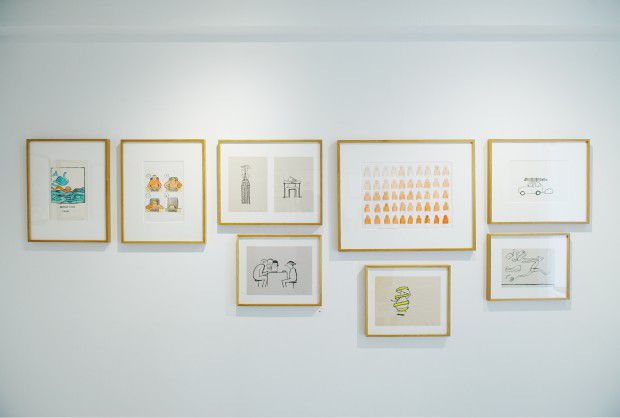
——素晴らしい絵の数々ですね。中には日本の海岸に似ているビーチもあって。
——These paintings are amazing. It’s interesting because some of these beaches almost look like the ones in Japan.
ジャン・ジュリアン「日本は海に囲まれているよね。昨夜誰かと話していたんだけど、これらの作品は日本のカルチャーとも共振するんだ。僕にとっては、だからこそそれがテーマであり、タイトルであって、だって、同じだから。’同じ海’なんだ。それに歴史的にも、日本ではたくさんの…例えば、鯉の凧とか?」
“And you are surrounded by the ocean. We were talking to somebody last night that it resonates with Japanese culture. And for me that’s also why it’s in the theme and title because it’s the same, you know? ‘The same sea.’ It’s also your iconography historically uses a lot of… like the carp for the kite?”
——子どもの日の鯉のぼりですね。
——For children’s day.
ジャン・ジュリアン「その通り。ああいったいろんなものの中に魚が見られる。このつぼは僕にとっては、その文化の改作ヴァージョンなんだ」
“Exactly. All that kind of stuff, you see fishes everywhere. The vases for me are sort of re-telling of that.”
——素晴らしいですね。魚のディテールが細かくて感心しました。
——They are amazing. I was pretty impressed how detailed those fishes are.
ジャン・ジュリアン「とても細かいんだ。実家のキッチンテーブルで描いたんだけど、実家にはいろんな魚の種類がわかる釣りの本がたくさんあってね。あの本と父が釣ってきた魚を参考に描いた」
“Very. That was me sitting at my parents’ kitchen table, and they have these books for fishing that identify all the different fishes. So I was drawing from that or the one my dad was bringing back from fishing.”
——これらのつぼは新たな試みですか?
——And these vases are your new medium?
ジャン・ジュリアン「300年の歴史を誇るブルターニュの陶器メーカー、Henriotとコラボレートしたんだ。彼らの工房を訪ねたら、20年代の古いモデルから1つ選ぶように言われた。中にはもうあまり使われていないものもあるんだけど、形が気に入ってこれを使うことにした」
“I collaborated with Henriot, which is a 300-year-old ceramics maker in Brittany. I went to visit their factory and they asked me to choose one of the old models from the 20s. Some of them they are not using much, so I decided to use this one because I like the shape.”
——今回はキャンバスに描かれた絵も展示されていますが、あなたのキャンバスの絵を初めて見ました。
——Also, I had never seen your paintings on canvas.
ジャン・ジュリアン「これまでに2回しか発表したことがないんだ。1回目は昨年12月にマイアミのArt Baselでグループショーに参加して、そこでビーチの絵をいくつか展示した。それから、今年2月に4枚の絵を手がけたのだけれど、ビーチの絵ではなかった。ビーチに特化した個展をやるのは今回が初めてなんだ。今回も展示している1枚の絵からアイデアを得たのだけど、マリブ(カリフォルニア州)のビーチで別の画家と一緒に描いた。かなりラフに描いてあって、ちょっと砂も付いているよ。すごく楽しい時間だった。僕にとって、それはラインドローイングとはまったく違った手法だった」
“I’ve shown it only couple of times. Once for Art Basel in Miami in December, I was showing in a big group show a few beach paintings. And then in February, I did four different paintings but not about beach. And this one is the first time I do a proper show just about that. And I started the idea on this one. I painted it on the beach on Malibu with another painter. It’s quite rough and there is a bit of sands on it. I had such a good time, and for me it’s such a different take from line drawing.”
——そして1階では、イラストレーションが展示されています。
——And downstairs, we can enjoy your illustrations.
ジャン・ジュリアン「日本で初めての個展だから、自分が普段やっていることを見せるのが良いのではないかと思ったんだ。それは僕が大好きなことでもあるから、自分の中の異なる側面を見せることができてすごく嬉しいよ。1階にはもっとユーモラスな絵が展示されている。中にはナショナル・ジオグラフィーのプロジェクトのオリジナルスケッチもあるよ」
“Because this is my first show in Japan, we thought it would be a good idea to show the collection of what I normally do. And that’s also something I love so I’m happy with the show because it shows different aspects of what I do. So downstairs, there are more humorous drawings, and some of them are also original sketches from the project with National Geography and different things like that.”
——日本のアニメや漫画を見て育ったそうですが、どんな作品が好きでしたか?
——You mentioned that you grow up watching Japanese anime and manga. What were some of the titles that you were into?
ジャン・ジュリアン「『聖闘士星矢』、『北斗の拳』、『シティーハンター』、それにもちろん『ドラゴンボールZ』」
“Saint Seiya,” “Ken (Fist of North Star),” “City Hunter” and “Dragon Ball Z” of course.
——アニメや漫画に限らず、日本のアーティストでインスパイアされる人はいますか?
——Not just anime or manga, but are there any Japanese artists you get inspired from?
ジャン・ジュリアン「Misaki Kawaiの作品が好き。あとは北斎も大好きだよ」
“I like what Misaki Kawai does. Also, a lot of Hokusai.”
——日本の雑誌も好きだそうですね。
——I heard that you like Japanese magazines as well?
ジャン・ジュリアン「僕が唯一買う雑誌だよ(笑)。『ポパイ』と『& Premium』が好きなんだ。今回の来日では彼らのオフィスを訪問したのだけど、僕はまるでファンの少年のように『写真撮ってもいいですか?』とかはしゃいでいた(笑)。僕は20歳くらいの頃から、コレットに行くためにパリに通っていたんだ。コレットでは雑誌を無料で閲覧できたから。そこで『relax』を読んで、いろんなアーティストについて知ったんだ」
“Yes. Those are the only magazines I buy [laughs.] I like Popeye and & Premium. I just went to visit their office, and I was like a fan boy asking, ‘can I take a picture?’ [laughs] From the age of about 20, I started getting into those magazines. When I was studying in Brittany, I was always going to Paris to visit Collette because you could browse magazines for free. And they had ‘relax.’ So I learned a lot about different artists from that magazine.”
——あなたの作品に描かれるユーモアやちょっとした日常の光景が大好きです。最近の最大のインスピレーション源は何ですか?
——I love the humor and little daily observations in your work. What are some of the biggest inspirations recently?
ジャン・ジュリアン「『となりのサインフェルド』(1989年〜1998年まで放送された、アメリカの国民的コメディードラマ)だよ(笑)。彼のほうがうまいけど、(僕のイラストレーションと)同じロジックなんだ。サインフェルドはいつも、『こんなことありませんでした?』と言うところから始める。それはまさに僕が日常的な作品でやろうとしていることなんだ。例えば、ドリップコーヒーは時間がかかってイラっとするなと思ったら、それについておかしな絵を描こうと思う。本質的には、スタンダップコメディアンがやっていることと同じだよ。彼らは自分に影響を与えたことについてのストーリーを語り、それがどれほど共感されるか試しているんだ。もし本当に共感できる内容だったら、観客は『うわー、あるある、私も!』となる。僕は人に気に入ってもらおうとしているわけではないけど、『私もまったく同じ!』と言われると、とてもやりがいを感じるよ」
“’Seinfeld.’ [Laughs] it’s so good. He does it much better, but it’s the same logic. He starts by saying, “have you ever notice…” And that’s what I try to do when I do daily stuff. For example, I would think that drip coffee takes too long, and it’s really annoying, so I try to find a way to do a funny cartoon about that. That’s essentially what stand-up comedians do. They tell a story of something that affected them and they are testing how relatable it is. If it’s really relatable, people are going to be like, “yeah, that’s true! Me too!” I don’t try to do stuff for people to like, but I find it very rewarding when people are like, ‘yeah, me too, totally!’”
——個人的な作品もあるし、コマーシャルな仕事もあるし、服のブランドもやっていて…常に何かを生み出していて忙しいのではないですか?クリエイティブな意味で行き詰まることはありますか?
——You have your personal art work, commercial work, clothing line… you must be so busy creating something all the time. Do you ever hit a creative wall?
ジャン・ジュリアン「もちろんあるよ!」
“Oh yeah, of course!”
——そんな時はどうしますか?
——What do you do?
ジャン・ジュリアン「もしビーチの近くにいたら、ビーチに行って絵を描けば大丈夫」
“If I’m at the beach, I just go to the beach and draw, and I’m fine.”
——ということは、この個展はあなたにとって完璧なプロジェクトですね。
——So this exhibition is a perfect project for you.
ジャン・ジュリアン「完全にね、間違いないよ!だから僕はとてもハッピーだし、このギャラリーも本当に美しいと思うんだ」
“Oh, completely, absolutely! That’s why I’m so happy and the gallery is so beautiful.”
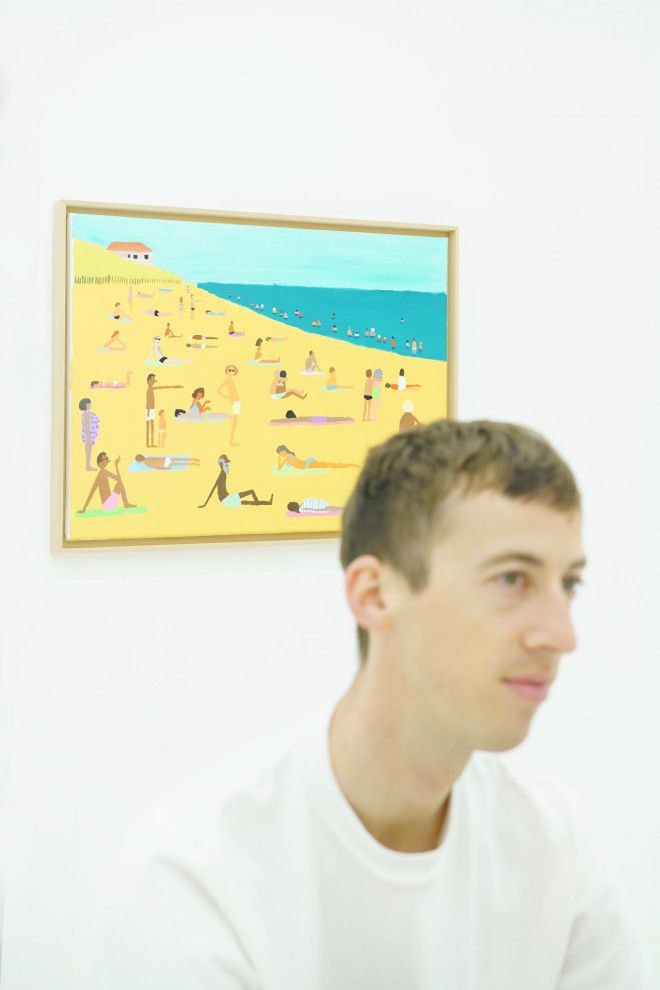
photography Satomi Yamauchi
text Nao Machida
「同じ海」
Jean Jullien
5月12日(土)- 26日(土)
Open 12-7 pm (日・祝休廊)
GALLERY TARGET
東京都渋谷区神宮前2-32-10
03 3402 4575
http://www.gallery-target.com
ジャン・ジュリアン:
フランス出身、現在ロンドンを拠点に活動するアーティスト。2008年にロンドン芸大のセントラル・セントマーチンズを卒業した後、2010年にロイヤル・カレッジ・オブ・アートにて修士号を取得。イラストレーションを軸に写真、動画またインスタレーションを製作するなど幅広い分野で活動している。過去にはロンドンのテートモダンやKemistry Gallery、LAとベルリンにあるHVW8、またシンガポール国立博物館など、世界各国で展示を行なっている。クライアントはニューヨーカー, ウォールストリート・ジャーナル、ナショナルジオグラフィック, UNICEF, ロンドン交通局など多岐に渡る。
http://www.jeanjullien.com/
